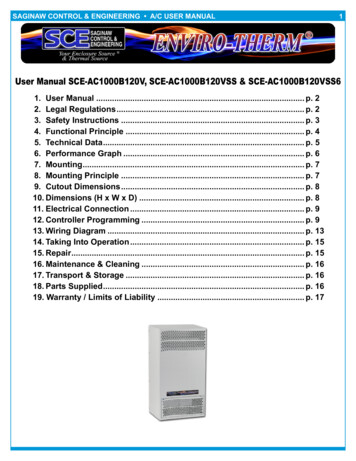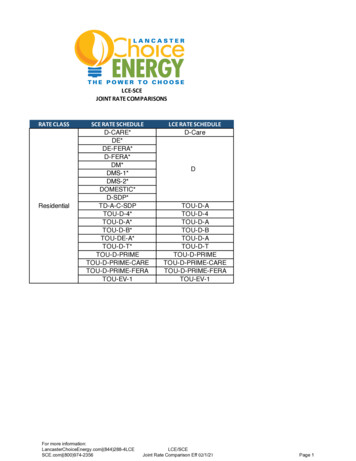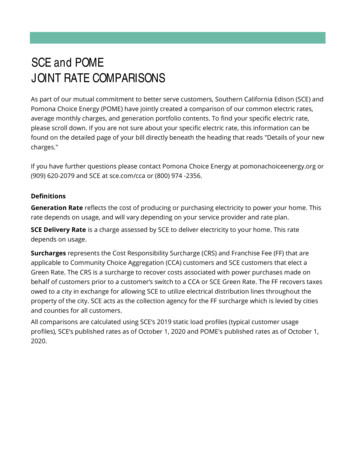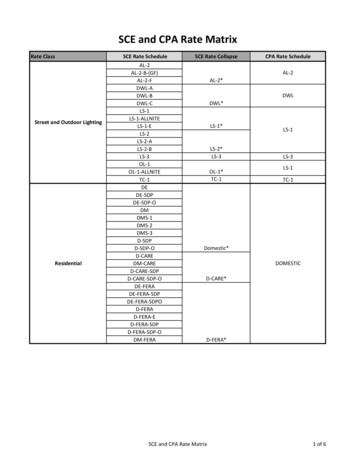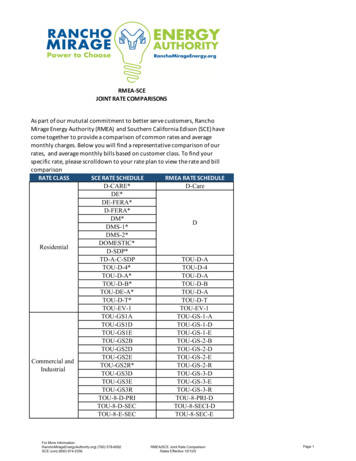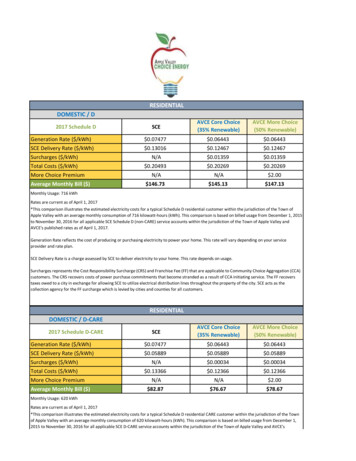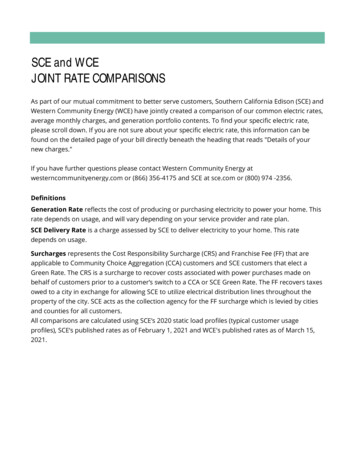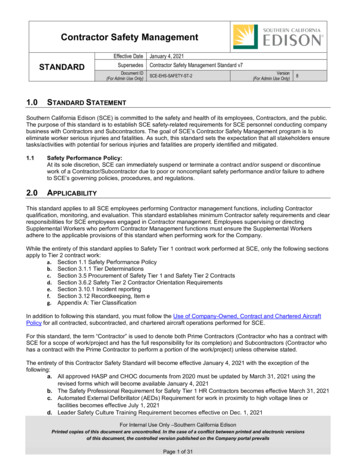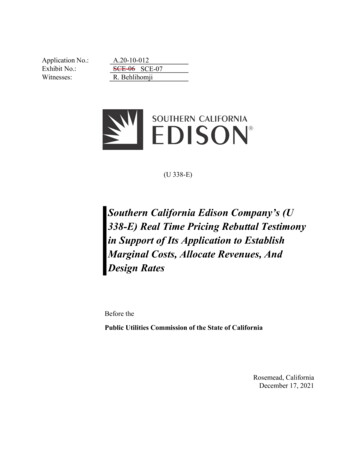
Transcription
Application No.:Exhibit No.:Witnesses:A.20-10-012SCE-06 SCE-07R. Behlihomji(U 338-E)Southern California Edison Company’s (U338-E) Real Time Pricing Rebuttal Testimonyin Support of Its Application to EstablishMarginal Costs, Allocate Revenues, AndDesign RatesBefore thePublic Utilities Commission of the State of CaliforniaRosemead, CaliforniaDecember 17, 2021
Southern California Edison Company’s (U 338-E) Real Time PricingRebuttal Testimony in Support of Its Application to Establish MarginalCosts, Allocate Revenues, And Design RatesTable Of ContentsSectionPageI.INTRODUCTION .1II.SCE HAS A LONG HISTORY WITH RTP AND IS ALREADYDEVELOPING A MARKET-BASED RTP RATE STRUCTURE .3III.IV.A.SCE Has Offered an RTP Rate Option for More Than 30Years .3B.SCE Is Already Participating in a Pilot to ExploreReplacing its Existing RTP Rate Structure with a MarketBased RTP Rate Structure .5C.SCE Has Used Customer Surveys to Inform its Approachwith RTP Rates .7JARP AND SBUA’S PROPOSALS SHOULD NOT BEADOPTED .8A.Adopting JARP and SBUA’s Proposals Would UndermineSCE’s Existing RTP Efforts Which Are Aligned with theCommission’s Framework for Dynamic Pricing Options .8B.JARP’s Proposed Widespread Rollout of Untested RTPRate Options Would be Bad for Customers, TakeSignificant Time, and Require a Significant Amount ofFunding .9C.JARP’s Proposed Rate Design for RTP Rate Options IsFlawed .101.JARP’s Proposed “Kill Switch” Improperly AllowsParticipants to Reap the Benefits of Dynamic PricesWhile Largely Avoiding the Risks .112.JARP’s Proposed Capacity Price Signal Does NotReflect Events Driven by Flex-Capacity orDistribution System Events.12CONCLUSION .14Appendix A Customer Perception of Real-Time Pricing: Survey Findings .-i-WitnessR. Behlihomji
1I.2INTRODUCTION3This rebuttal testimony addresses the direct testimony of the Joint Advanced Rate Parties4(JARP)1 and the Small Business Utility Advocates (SBUA) concerning real time pricing (RTP) rate5design.2 SCE did not propose an RTP tariff using wholesale market prices from the California6Independent System Operator (CAISO) in its direct testimony. Instead, SCE highlighted its existing7RTP rate schedules, which offer a menu of temperature triggered hourly prices, determined one day in8advance, to general service customers who choose to participate in the RTP program.3 SCE further9indicated its intent to continue to explore the opportunity to incorporate wholesale energy prices from10the CAISO into the RTP rate design upon SCE’s Customer Service Re-Platform (CSRP)11implementation.412Both JARP and SBUA recommend that SCE develop RTP rate options that incorporate13wholesale energy prices from CAISO as part of this proceeding. SBUA recommends that the assigned14Administrative Law Judge bifurcate this proceeding and direct SCE to file an RTP pilot proposal in a15separate track.5 While SBUA does not propose specific rate design details for this recommended pilot,16SBUA recommends that SCE review the testimony and settlements in Pacific Gas & Electric17Company’s (PG&E) commercial electric vehicle (CEV) day-ahead real-time pricing (DAHRTP) pilot18and GRC Phase 2 proceedings (A.20-10-011 and A.19-11-019).6 Similarly, JARP recommends that the19Commission:1. Require SCE to develop RTP rate options that pass-through CAISO energy market prices;20123456The JARP are California Solar and Storage Association, Enel X North America, Inc., and Tesla, Inc.This testimony is timely served pursuant to the November 13, 2021 Email Ruling Granting SCE’s Request forExtension of Time to the Schedule.Exh. SCE-04, p. 57.Id., p. 58.SBUA Direct Testimony, p. 47.Id.1
2. Base the RTP rate on day-ahead hourly energy market prices times a loss factor, while also12including a Marginal Generation Capacity Cost component to recover embedded generation3capacity costs and a time-varying revenue neutral adder to collect above-market or non-4marginal generation costs;3. Implement RTP rate options for residential, general service (commercial and industrial), and5agricultural customers on a permanent basis, while instituting an annual study process;64. Require SCE to file supplemental testimony proposing investments in (1) billing system78upgrades to enable customer billing on hourly generation rates, (2) an RTP pricing engine to9generate and distribute day-ahead price schedules, and (3) marketing, education, andoutreach (ME&O);105. Provide guidance as to whether any express modifications are needed to Rule 24 or Share My1112Data to enable third-party access to customer data for purposes of enabling and tailoring13customer response to a market-informed RTP rate; and146. Preserve the ability for energy price-based RTP customers to also participate in SCE’s Base15Interruptible Program and the Day-Ahead Option of its Capacity Bidding Program, and16extend this dual participation allowance to other day-of dispatched demand response17options.7For the reasons discussed below, SCE recommends that the Commission reject SBUA and1819JARP’s RTP proposals.7JARP Direct Testimony, pp. 2-3.2
1II.2SCE HAS A LONG HISTORY WITH RTP AND IS ALREADY DEVELOPING A MARKET-3BASED RTP RATE STRUCTURE4A.SCE Has Offered an RTP Rate Option for More Than 30 YearsAlthough not based on CAISO energy market prices, SCE’s existing RTP schedules offer menus56of hourly prices to general service customers who choose to participate in the RTP program. The7applicable pricing menu is determined one day in advance based on the maximum temperature recorded8on the prior day at the Los Angeles Civic Center.8 The hourly RTP rates are designed to be revenue9neutral to recover the generation revenue requirement of each RTP schedule’s Otherwise Applicable10Tariff (OAT).9 The Capacity Allocation Tool, as described in Exhibit SCE-02, is used to determine the11underlying seasonal hourly price profiles for energy and capacity.10 Distribution charges are the same as12each RTP schedule’s OAT.11 In SCE’s 2018 GRC Phase 2 proceeding, SCE updated this RTP structure13to reflect an energy price profile aligned with current market conditions and a resource mix that included14a flex capacity price signal accompanying the peak capacity price signal that had been in the rate since15inception.12SCE has offered an RTP rate option for more than 30 years. The RTP rate option was initially1617launched in 1987 as a pilot with 10 accounts participating. Over the years, SCE has broadened the18availability of this rate option from a limited number of commercial and industrial customers to general19availability for all non-residential and non-lighting rate groups. Currently, SCE has approximately 10020RTP customers in various rate classes, including medium and large commercial and industrial89101112Exh. SCE-04, p. 57.Id., p. 58.Id.Id.The initial proposal for this change was filed in SCE’s 2016 Rate Design Window, A.16-09-003.3
1customers.13 As the following shows, SCE has broadened the availability of its RTP rate option in2recent years: 3Before 2009, only large accounts with demands higher than 500 kW (TOU-8) were eligibleto be enrolled in RTP.4 5Beginning in 2010, SCE provided the option of enrolling in its RTP rate to Agricultural &Pumping accounts (TOU-PA-2 and TOU-PA-3).6 7In 2013, SCE opened eligibility to Commercial & Industrial (C&I) accounts with demandsbetween 200 kW and 500 kW (TOU-GS-3).8 9Finally, in 2015, smaller C&I accounts with demands less than 20 kW (GS-1) and between20 kW to 200 kW (GS-2) became eligible to enroll in RTP.10Overall, SCE’s RTP rate structure presents a compromise between a dynamic price signal and1112reasonably providing participants sufficient notice to plan business end-use for effective and responsive13demand management. The day-ahead temperature trigger helps reach this balance by effectively14providing participants a five-day notification given that temperature forecasts are readily available15through various sources over a five-day period. Additionally, the temperature trigger also maintains16sufficient correlation with temperature-driven system constraints that can often span multiple days. The17additional notice contributes to participants’ level of comfort with the program and helps facilitate the18level of load drop delivered by the program. For example, a 2017 study SCE delivered at the Center for19Research in Regulated Industries (CRRI) Western Conference in Monterey showed an average of nearly2050% peak hour load drop on highest priced summer weekdays and an average of 35% peak hour load21drop on the second highest priced summer weekdays for 140 participating accounts in 2015.141314SCE currently offers the RTP rate option for all consumer classes except for residential customers andlighting. Number of customers reflects the count as of December 1, 2021.“Real Time Pricing (RTP) at Southern California Edison (SCE)” white paper, R. Garwacki, L. Pan, and C.Sorooshian, at p. 18.4
1B.SCE Is Already Participating in a Pilot to Explore Replacing its Existing RTP Rate2Structure with a Market-Based RTP Rate Structure3SCE recognizes the limits of a temperature-based trigger and appreciates that its existing RTP4rate lacks a trigger that correlates with flex capacity constraints.15 In 2017, SCE began exploring a5replacement for its existing RTP structure by participating in a transactive energy pilot, sponsored6through a California Energy Commission (CEC) Electric Program Investment Charge (EPIC) grant, in7the Moorpark region.16 The pilot tested as a proof-of-concept the possibility of deploying, for a select8sample of 100 residential customers, a technology-based platform that TeMIX, the project sponsor,9called Retail Automated Transactive Energy System (RATES). The RATES pilot assessed a behind-10the-meter energy management solution that minimized the cost and complexity of interfacing with11consumers and their devices, and a technology platform that interfaced with SCE (as a Distribution12System Operator or DSO) and the CAISO (as an Independent System Operator or ISO).The pilot instituted a subscription based transactive price that was designed to use tenders and1314transactions as the basis of demand side management. This allowed a risk averse customer to self-select15and lock-in the amount of load exposure to the dynamic price, which SCE views as vital to ensuring16broad customer acceptance. RTP rate structures with a menu of generation based real time prices that17are supplemented with traditional tariff based retail delivery rates have been available for a number of18years, but have failed to gain widespread customer adoption for a number of reasons. This is potentially19due to the complexity of the rate, the volatility inherent with hourly market-based pricing, and the lack20of automation. The subscription rate supported by the TeMIX platform is a potential solution to21overcome these participation barriers by providing the simplicity and security of subscription pricing1516SCE’s current RTP schedules offer a menu of prices by seasonal day-type based on a temperature gradientthat has typically been correlated with peak load system constraints. In the 2018 GRC the RTP scheduleswere updated by consolidating day-types and included both peak and ramp driven capacity marginal costs thataligned with SCE’s change in TOU periods.See “CEC-500-2020-038: Complete and Low-Cost Retail Automated Transactive Energy System ed-transactiveenergy-system/.5
1(e.g., current cellphone plans that combine data and calling into one monthly rate) in addition to2automated load response for bill management and grid support.Phase 1 of the pilot ran from 2016 to 2019. Through the pilot, SCE learned about the essential34elements needed for the successful deployment of such a technology-based dynamic price platform.5Namely, this pilot illustrated that successful implementation of dynamic prices requires enhanced6technology interfaces between the DSO, the ISO, and the customer’s energy management system that7communicate in real time. In addition, communication protocols for both metered load and price8information must be standardized and designed with sufficiently robust security parameters.17Phase 2 of the RATES pilot is expected to begin in the Summer of 2022 and extend through the910Summer of 2024. This phase of the pilot was proposed by SCE in Phase 2 of the Reliability proceeding,11R.20-11-003, and recently approved in the Commission’s December 6, 2021 decision, D.21-12-015, that12takes several demand-side and supply-side measures to reliably meet load needs in 2022 and 2023.1813While SCE is still in the process of fully scoping out this phase of the pilot, D.21-12-015 orders SCE to14“conduct a mid-term and final evaluation of the pilot to assess the costs and benefits of real-time rates,15including required infrastructure, manufacturer interest, and customer impacts. The mid-term report16shall be released no later than December 31, 2023, and a final evaluation shall be released no later than17March 1, 2025.”19 More specifically, SCE’s evaluation must include the following elements:171819The knowledge gained from SCE’s participation in this TeMIX pilot subsequently helped inform the EnergyDivision’s RTP framework (UNIDE), which Energy Division described in its May 25, 2021 workshop onAdvanced DER and Demand Flexibility Management. See “Forward Looking Vision: Advanced DERs &Demand Flexibility Management,” Aloke Gupta, DR Section, Energy Division, May 25, lexibility-management/slides-unideworkshop gupta.pdf, pp. 38, 39, 45.D.21-12-015, Phase 2 Decision Directing Pacific Gas and Electric Company, Southern California EdisonCompany, and San Diego Gas & Electric Company to Take Actions to Prepare for Potential Extreme Weatherin the Summers of 2022 and 2023, December 6, 2021, pp. 96-99 and Ordering Paragraphs (OPs) 59-63.Id., p. 99.6
11. An evaluation of load responsiveness. SCE should evaluate the efficacy of the pilot tariff2in shifting loads enrolled in the program from peak to off-peak periods and should be3compared to non-participant loads;2. The monthly bill impacts of the pilot dynamic rate in comparison to a customer’s4otherwise applicable tariff; and53. An evaluation of the cost recovery which assess[es] the impact of any under-collection of67revenues associated with the pilot similar to the evaluation required of the [Valley Clean8Energy] dynamic rate pilot.209C.SCE Has Used Customer Surveys to Inform its Approach with RTP RatesSCE has been, and will continue to be, supportive of the Commission’s efforts to develop and1011deploy RTP rate structures as the State transitions into a lower greenhouse gas future. As such, in12addition to the pilot efforts discussed above, in Spring 2021, SCE conducted surveys, in coordination13with the Electric Power Research Institute (EPRI), to gauge residential and small business customer14perception of RTP rates.21 A majority of residential and small business participants in this survey15wanted some form of hedging to protect against price volatility.22 Additionally, 100% of electric vehicle16(EV) fleet small business customers and 75% of small business customers with energy/load management17systems indicated in this survey they would likely enroll in a conceptual RTP rate broadly described as18one with hourly dynamic prices to facilitate load flexibility and one that would be technology enabled.23Insights gained from these surveys are likely to be a focus area for the second phase of the1920RATES pilot which, as noted above, is set to begin in the Summer of 2022.20212223Id., p. 99. See also Id., OPs 59-63 and Attachment 1, pp. 10-12.See Customer Perception of Real-Time Pricing: Survey Findings, EPRI and SCE, April 2021, attached heretoas Appendix A (the survey findings for small business customers start at A-1, while the survey findings forresidential customers start at A-43).Id., pp. A-9 (small business), A-51 (residential).Id., p. A-23.7
1III.2JARP AND SBUA’S PROPOSALS SHOULD NOT BE ADOPTED3A.Adopting JARP and SBUA’s Proposals Would Undermine SCE’s Existing RTP Efforts4Which Are Aligned with the Commission’s Framework for Dynamic Pricing Options5As shown above, SCE is aware of the need to update its existing RTP rate and has taken6significant steps since 2017 to methodically develop and implement a transactive dynamic rate structure.7SCE’s approach recognizes RTP structures do not exist in isolation but rather are reliant on (1)8correlating real time localized or system load data into prices that help real time grid management, (2)9infrastructure and technology platforms to enable the seamless transfer of prices to participants, (3)10coordination with device manufacturers or energy management systems for truly flexible load control,11and (4) customer acceptance of a new type of service that can be significantly more volatile than12traditional rate options. As these necessary considerations show, successful implementation of a13revolutionary design that conveys real time dynamic prices takes careful planning to get right.14Moreover, a material transition from predictable and stable time-of-use (TOU) rates to dynamic prices15that vary and change on an hourly basis every day requires a solid foundation of testing, analysis, and16performance measurement.24 Thus, the best way to realize the full potential of dynamic prices is17through structured and deliberate execution of pilots that incrementally test the impact such prices can18have on grid and/or load management, consumption behavior, consumer bills, and the utility’s revenue19recovery potential. SCE’s ongoing methodical approach through its survey efforts and the first phase of20the RATES pilot has enabled SCE to learn much about such considerations. SCE will learn even more21through the second phase of that pilot.SCE’s methodical approach is also consistent with the efforts underway at the Commission.2223The Commission’s July 23, 2021 Draft Distributed Energy Resources Action Plan Aligning Vision and24Action (Draft CPUC DER Action Plan 2.0) establishes an organized, step-by-step framework so that24While generally correlated, SCE views the pricing architecture of dynamic prices somewhat differently fromstandard TOU rates that are intended to convey long-run equilibrium prices that help consumers moderateconsumption behavior and investment decisions over time.8
1“CPUC staff and stakeholders can strive to work efficiently and coherently towards a clean energy2future with a large participation of DERs.”25 While SCE has concerns with some of the timing aspects3in the Draft CPUC DER Action Plan 2.0, SCE strongly supports the Commission’s methodological4approach that considers key aspects of electric service under an RTP rate structure. In contrast to SCE’s5approach and the Draft CPUC DER Action Plan 2.0 framework, however, JARP’s proposals for a rapid6implementation across customer classes of what amounts to an early conceptual rate design framework7does not seriously consider any of the interim steps required to make a market-based RTP rate a viable,8successful option.26Moreover, if JARP or SBUA’s proposals are adopted, SCE would essentially have to start over910in its RTP rate development efforts rather than continuing the promising start in developing both a11platform and a rate structure through the RATES pilot. This is unreasonable considering that SCE’s12existing efforts are aligned with, and have informed, the CPUC and CEC framework regarding dynamic13pricing options, and would also create additional unnecessary costs for customers. For those reasons,14the Commission should not order SCE to develop new RTP rate options or to submit a new pilot15proposal in this proceeding.16B.JARP’s Proposed Widespread Rollout of Untested RTP Rate Options Would be Bad for17Customers, Take Significant Time, and Require a Significant Amount of Funding18The biggest problem with JARP’s proposed RTP rates is that they are supported by an early19conceptual framework that has not been adequately vetted through either a stakeholder process or20structured pilots.27 Thus, they are far from ready to be rolled out to customers. As indicated above, the21design for an effective dynamic rate is complex and requires accounting for numerous complicated252627Draft CPUC DER Action Plan 2.0, ic.pdf, p. 5 (VisionElement 1).See, e.g., JARP Direct Testimony, p. 19 (“The JARP also have not developed a cost estimate for theimplementation activities.”); id. (“Regarding ME&O to customers, JARP do[es] not advocate for an extensivecampaign.”).See, e.g., id. (“The JARP do not have the resources or expertise required to develop the actual rate.”).9
1considerations, such as ensuring the required infrastructure and technologies are in place, that customers2will broadly accept the rate, and equitable treatment of non-participating customers.3Working out these considerations requires testing, analysis, and performance measurement, like4what SCE intends to do with the different phases of the RATES pilot. But JARP proposes to skip all of5that. Instead, JARP proposes that its proposed dynamic rate options immediately be made available6across all customers classes on a permanent basis without a cap on enrollment.28 JARP would then7leave considerations such as whether the dynamic rate options are actually revenue neutral and whether8they avoid cost shifts to non-participating customers to be worked out after-the-fact through an annual9Tier 3 Advice Letter process that reviews customer, developer, and ratepayer outcomes.29 This is10entirely backwards and would likely lead to chaotic annual rate adjustments in which customers are11removed from participation or lose benefits they have come to enjoy on the rate, or in which structural12revisions to the rate are made causing customer confusion. That is bad ratemaking and bad for13customers.Moreover, JARP’s proposal is unfunded. JARP recognizes that making RTP rate options widely1415available to customers will require millions of dollars in foundational investments and implementation16efforts, including billing system upgrades, an RTP pricing engine, customer notifications, and ME&O.3017As such, JARP submits that SCE should be ordered to submit supplemental testimony to estimate these18implementation costs.31 But when considering the proposed hasty widespread implementation, the lack19of detailed rate design, and the proposed annual review and adjustment process, the scope of JARP’s20proposal is so broad that a realistic budget cannot be developed.21C.In addition to the significant flaws with JARP’s proposed implementation plan, JARP’s proposed2223JARP’s Proposed Rate Design for RTP Rate Options Is Flawedrate design for RTP rate options is flawed. While many of the rate elements JARP proposes are already28293031Id., p. 16.Id.Id., p. 19.Id., p. 20.10
1reflected in the RATES pilot RTP structure (such as hourly CAISO energy pricing, hourly generation2peak capacity cost, pricing-based triggers rather than temperature-based triggers, and a hedging3mechanism to limit the impact of a potentially volatile RTP pricing structure), there are two major flaws.1.4JARP’s Proposed “Kill Switch” Improperly Allows Participants to Reap the5Benefits of Dynamic Prices While Largely Avoiding the Risks6First, JARP’s proposed “kill switch” is inappropriate. According to JARP, the function7of this “kill switch” is to automatically revert to the customer’s otherwise applicable tariff “in the case of8a severe natural disaster, such as a large earthquake, that results in a multi-day grid outage or emergency9that keeps prices high.”32 JARP proposes that the “kill switch” be triggered if total day-ahead Marginal10Generation Costs are forecasted at or above a specified price threshold for a specified number of11consecutive hours or if the grid remains in a state of real-time Transmission Emergency or Energy12Emergency Alert at any stage for more than the same specified number of hours.33 The kill switch13would continue to apply to intervals after the threshold is reached until the underlying price or14emergency conditions subside.34 JARP defends this structure as ensuring beneficial customer outcomes15from taking service on an RTP rate.SCE agrees a hedging mechanism is critical to the broader acceptance of an RTP rate1617structure. Our years of experience with RTP and the direct feedback from the EPRI/SCE RTP customer18perception survey results confirm that the potential of exposure to extreme price volatility is a major19deterrent to RTP participation.35 There also may be circumstances in which exceptions to dynamic20pricing should be considered for vulnerable customer groups in the event of earthquakes or other natural21disasters. However, JARP’s proposed “kill switch” goes too far by potentially allowing participants to22receive the upside benefit from dynamic price differentials over the course of normal operating23conditions while largely avoiding the downside risk from prices increasing during significant reliability32333435Id., p. 16.Id., p. 16.Id., pp., 16-17.See Appendix A, pp. A-9 (small business), A-53 (residential).11
1or residency events. In other words, this design would allow participants to take full advantage of low2market prices while limiting their exposure to high market prices during some peak grid conditions.3SCE recognizes that the complete details of JARP’s proposed “kill switch” were not4provided in JARP’s direct testimony. However, the brief description that was provided by JARP implies5that the price threshold triggering of the kill switch could be established below the current market price6caps set by the CAISO and that operation of the kill switch could continue to apply over a multi-day7period, removing dynamic rates as a demand management tool when the program is needed the most.8The result would be dynamic prices becoming a subsidized and discounted rate with limited benefits to9non-participants.A more effective hedging mechanism is being explored through the RATES pilot. There,1011SCE is exploring the use of a subscription rate structure where participants can set their level of12exposure to dynamic pricing based on an amount of load that is “fixed” with the balance exposed to13hourly dynamic pricing. The subscription price model has the benefit of retaining these individual14hedging positions through dynamic pricing events, thus maintaining a level of risk protection for those15customers who prefer more stable bills while offering higher price volatility exposure for those16customers who can provide a response during these events.For these reasons, the Commission should reject JARP’s “kill switch” proposal and allow1718SCE to continue exploring a potentially viable subscription-based hedging mechanism through phase 219of its RATES pilot.202.JARP’s Proposed Capacity Price Signal Does Not Reflect Events Driven by Flex-21Capacity or Distribution System Events22Second, the component driving price differentials embedded in JARP’s proposal is23primarily capacity costs and not hourly energy prices. This is also the case with SCE’s existing RTP24rate structures. SCE’s design of standard TOU rates currently includes a generation capacity price25signal that is based on the long-run marginal cost of providing such capacity at the time of reliability26need. SCE appropriately uses long-run marginal costs in the design of standard rates for various27reasons, including that (i) rates are designed to reflect the appropriate blend of short-run and long-run12
1marginal costs as a price signal, and (ii) investments in capacity have long lead times to service,2extended useful lives, and are lumpy in nature. When designing dynamic prices, it is important that3sufficient consideration be given to the design of such capacity costs. JARP’s current proposal of4establishing a capacity signal, however, does not appropriately represent the design of dynamic prices5by:61. Only considering the peak load system constraint and ignoring the evolving ramp7system constraint driven by the proliferation of intermittent supply side resources and8DERs;92. Permitting an arbitrage opportunity by concentrating the recovery of long-run10capacity marginal costs to a few hours of the year that are based on a predictable11and/or pre-determined load threshold;123. Ignoring the importance of short-run capacity planning, and, by extension, the13recovery of such costs in non-peak months of the year under normal operating14conditions; and1516174. Ignoring the need for an RTP rate to encourage load shedding or shifting duringperiods of distribution system peak events.In sum, any proposal on dynamic price rates that includes a capacity price signa
3 1 II. 2 SCE HAS A LONG HISTORY WITH RTP AND IS ALREADY DEVELOPING A MARKET- 3 BASED RTP RATE STRUCTURE 4 A. SCE Has Offered an RTP Rate Option for More Than 30 Years 5 Although not based on CAISO energy market prices, SCE's existing RTP schedules offer menus 6 of hourly prices to general service customers who choose to participate in the RTP program.
